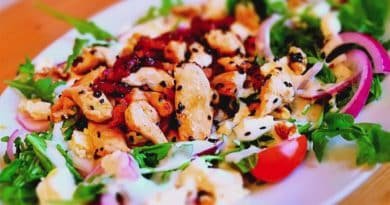Rice Alternative for Diabetes: Top 11 Benefits for Diabetic Diets
Are you searching for the perfect rice alternative for diabetes that doesn’t compromise on taste or nutrition? If you’re managing diabetes, rice’s high glycemic index can be problematic as it can lead to spikes in blood sugar levels. Numerous rice alternatives for diabetes are delicious and versatile, offering a range of flavors and textures.
Rice is a staple food, and it’s hard to give up. Its versatility and ability to pair with almost any dish make it a beloved carbohydrate around the globe. It is enjoyed in various cuisines, from Asian stir-fries to Latin American dishes.
Quinoa, for instance, is a protein-packed grain that provides a hearty bite, while cauliflower rice offers a low-carb, nutrient-dense option with a mild flavor that complements many dishes.
Let’s explore how they can fit into the meals, making the journey to better health enjoyable and tasty.
Rice Alternative for Diabetes: Expert Recommended for Friendly Diet
1. Cauliflower Rice
Cauliflower rice is a fantastic low-carb, low-calorie substitute for traditional rice. Made by grating or processing cauliflower into small, rice-like pieces, it’s easy to prepare and incredibly versatile. You can sauté it with your favorite spices, mix it into a stir-fry, or use it as a base for a nutritious grain bowl.
It is a healthier alternative and adds a subtle, delicious flavor to various dishes. It’s packed with vitamins and nutrients, making it a great addition to any meal plan.
Benefits of Cauliflower Rice
- Low Glycemic Index: Cauliflower rice has a very low GI, making it an excellent choice for people with diabetes.
- Nutrient-rich: Packed with vitamins C, K, and B6, fiber, and antioxidants.

2. Quinoa
Quinoa is a protein-rich grain lower in carbs than rice, making it a popular choice for those looking to reduce their carbohydrate intake. It’s a complete protein containing all nine essential amino acids, which is rare for plant-based foods.
Quinoa is packed with fiber, vitamins, and minerals like magnesium, iron, and potassium, contributing to overall health and well-being. Its versatility in cooking also allows it to be used in various dishes, from salads to soups to main courses.
Benefits of Quinoa
- Moderate Glycemic Index: Quinoa has a moderate GI, making it a better option than white rice.
- High in Fiber and Protein: These nutrients help slow down the absorption of sugar into the bloodstream.

3. Barley
Barley is another excellent grain that serves as a rice alternative for diabetes. Rich in essential nutrients, it’s chewy, nutty, and full of fiber, making it an excellent choice for maintaining blood sugar levels.
Barley is versatile and can be used in soups, salads, and stews, adding texture and flavor to meals.
Benefits of Barley
- Low Glycemic Index: Barley ranks low on the GI scale and benefits blood sugar control.
- Rich in Beta-Glucan: This fiber helps improve insulin sensitivity and lower blood sugar levels.

4. Lentils
Lentils are a powerhouse of nutrition, offering an excellent source of protein, fiber, and a variety of essential vitamins and minerals such as iron, folate, and magnesium. They are versatile and easy to cook but can also be used as a rice substitute in many dishes, adding a hearty texture and rich flavor.
Lentils are a delicious and healthy addition to any meal plan, whether you incorporate them into soups, stews, salads, or casseroles.
Benefits of Lentils
- Extremely Low Glycemic Index: Lentils have one of the lowest GIs among carbohydrate-rich foods.
- Nutrient-Dense: High in protein, iron, and folate, they offer substantial health benefits.

5. Shirataki Rice
Shirataki rice, or miracle rice, is made from the konjac plant, a root vegetable native to Asia. It’s virtually calorie- and carbohydrate-free, making it an excellent choice for low-carb or low-calorie diets. Its unique texture and ability to absorb flavors from sauces and seasonings make it a versatile addition to various dishes.
Benefits of Shirataki Rice
- Zero Glycemic Impact: Shirataki rice contains no digestible carbs, so it doesn’t impact blood sugar levels.
- High in Glucomannan: This fiber promotes satiety and supports digestive health.

6.Broccoli Rice
Broccoli rice is like cauliflower rice but offers a unique flavor profile. It’s made by processing fresh broccoli into tiny, rice-like pieces, making it a nutritious and low-carb alternative to traditional rice.
Versatile ingredients can be sautéed, steamed, or used in various dishes, adding texture and a boost of vitamins.
Benefits of Broccoli Rice
- Low Glycemic Index: Like cauliflower, broccoli is low in carbs and high in fiber.
- Rich in Nutrients: High in vitamins C, K, and A, as well as fiber and various antioxidants.

7. Zucchini Rice
Zucchini rice offers a fresh twist on replacing traditional rice, serving as a nutritious, low-carb alternative. You can craft a light, refreshing option that complements many dishes by grating or processing zucchini.
The choice boosts nutritional value and introduces unique flavors and textures to a meal. Whether aiming to cut down on carbs or explore new culinary adventures, zucchini rice stands out as versatile and tasty.
Benefits of Zucchini Rice
- Hydrating: Zucchini is mostly water, helping you stay hydrated.
- Low in Calories: It’s an excellent option for reducing calorie intake.

8. Cabbage Rice
Cabbage rice is a surprisingly satisfying option that mimics the texture of traditional rice and delivers a hefty dose of nutrients. Finely chopped cabbage can be sautéed with garlic, onions, and various spices to create a flavorful base.
It’s an excellent low-carb alternative that pairs well with various dishes, from stir-fries to curries, making it a versatile addition to any meal plan.
Benefits of Cabbage Rice
- Low Glycemic Index: Cabbage is very low in carbs and high in fiber.
- Nutrient-rich: Rich in vitamins C and K, folate, and fiber.

9.Brown Rice
While not as low-carb as other options, brown rice is better than white rice due to its lower glycemic index (GI) and higher fiber content.
The fiber in brown rice aids digestion and helps maintain steady blood sugar levels making it a healthier choice for long-term well-being.
Benefits of Brown Rice
- Lower Glycemic Index: Brown rice has a lower GI than white rice, making it a slightly better option.
- Nutrient-Dense: Higher in vitamins, minerals, and fiber than white rice.

10. Farro
Farro, a grain with ancient origins, is celebrated for its nutty taste and chewy consistency. Originating from the Fertile Crescent, it has been a staple in Mediterranean diets for centuries.
Farro is higher in protein and fiber than many other grains, making it a nutritious addition to salads, soups, and side dishes.
Its satisfying texture and rich flavor complement a variety of ingredients, from fresh vegetables to hearty meats. Farro offers a versatile and healthy option for any meal, whether warm or cold.
Benefits of Farro
- Moderate Glycemic Index: Farro’s GI is lower than white rice’s.
- Rich in Nutrients: Packed with protein, fiber, magnesium, and zinc.

11. Bulgur
Bulgur is a form of whole wheat that’s been cracked and partially cooked, making it a convenient and versatile ingredient.
It’s quick to prepare, often taking a few minutes to cook, and highly nutritious, providing essential vitamins, minerals, and fiber.
Ancient grain is commonly used in Middle Eastern and Mediterranean cuisines, adding a wholesome texture and flavor to dishes like tabbouleh and pilafs.
Benefits of Bulgur
- Low Glycemic Index: Bulgur is low on the GI scale, which helps control blood sugar levels.
- Fiber-Rich: High in dietary fiber, aiding digestion and promoting satiety.

Why Look for a Rice Alternative?
Understanding Diabetes and Carbohydrates: Diabetes affects how a body processes blood sugar. Consuming foods high in carbohydrates, like rice, can cause spikes in blood glucose levels. The goal is to find foods that provide similar satisfaction without those unwanted spikes.
Glycemic Index and Its Importance: The glycemic index (GI) measures how quickly a food raises blood sugar levels. High-GI foods, such as white rice, cause rapid increases. Opting for low-GI foods helps maintain steady blood sugar levels, which is essential for managing diabetes.
Combining Foods for Better Control
Pairing with Protein: Rice substitutes like cauliflower rice or quinoa paired with proteins such as beans, chicken, or tofu can help balance blood sugar levels.
Protein is vital in delaying the absorption of carbs into the bloodstream, helping avoid sudden blood sugar increases. This approach is beneficial for people managing diabetes or those who want to keep their energy levels consistent throughout the day.
Incorporating Healthy Fats: Healthy fats like avocado, olive oil, or nuts can further help manage blood sugar levels by slowing digestion and promoting satiety.
These healthy fats contribute to blood sugar management, provide essential nutrients, and support heart health.
Including a variety of healthy fats in your diet can enhance the overall nutritional quality of meals while keeping you fuller for longer.
Cooking Tips: Rice Alternative for Diabetes
Seasoning and Flavoring: Experimenting with herbs, spices, and healthy sauces can make these rice alternatives more appealing. For instance, adding garlic, ginger, or turmeric can significantly enhance your meals’ flavor and nutritional value.
Incorporating fresh herbs like cilantro, parsley, or basil can bring freshness and complexity to your dishes. Don’t hesitate to try different spice blends from various cuisines to keep your meals exciting and flavorful.
Proper Preparation: Some rice alternatives, like quinoa and barley, need to be rinsed before cooking to remove any bitter coating. This step ensures a better taste and texture.
Moreover, using low-sodium broth instead of water can add extra flavor to your dishes without the need for added sugars or unhealthy additives.
For grains such as farro or bulgur wheat, following the package instructions for soaking and cooking times can also significantly improve the final dish quality.
Meal Prepping: Meal prepping with rice alternatives can save time and ensure you always have a healthy option. By cooking a big batch at the beginning of the week and storing it in airtight containers, you can easily incorporate these nutritious grains into your meals.
This strategy can help you avoid the temptation of less healthy fast-food options when you’re short of time. Prepped meals can be customized with different vegetables, proteins, and sauces to create a variety of balanced and delicious meals, making your weeknight dinners both convenient and enjoyable.
Final Verdict of Rice Alternative for Diabetes
Finding a rice alternative for diabetes doesn’t mean sacrificing taste or satisfaction. From cauliflower rice to hearty lentils, numerous delicious and nutritious options are available.
By making thoughtful choices, you can enjoy meals supporting your health goals without compromising flavor.
Remember, managing diabetes is about finding balance and making informed decisions—and with these rice alternatives, you’re well on your way to a healthier lifestyle.
FAQs of Rice Alternative for Diabetes
Q: Can I eat brown rice if I have diabetes?
A: Brown rice is a better option than white rice due to its lower glycemic index and higher fiber content.
Q: How often should I eat rice alternatives?
A: Incorporating rice alternatives can help manage blood sugar levels. Aim to include them in your meals several times a week.
Q: Are there any carb-free rice alternatives?
A: Shirataki rice is virtually carb-free, making it an excellent option for those strictly managing carbohydrate intake.
Q: Can children with diabetes eat these rice alternatives?
A: These rice alternatives are safe and nutritious for children with diabetes. They provide essential nutrients while helping manage blood sugar levels.
Q: How do I know which rice alternative is best for me?
A: Experiment with different rice alternatives to see which ones you enjoy the most. Consider factors like taste, texture, and nutritional content to find your perfect match.





Pingback: Civet Coffee Benefits: Unique Flavor to Health Boosters